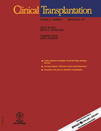Choice of calcineurin inhibitor may influence the development of de novo immune hepatitis associated with anti-GSTT1 antibodies after liver transplantation
Abstract
Aguilera I, Sousa JM, Praena JM, Gómez-Bravo MA, Núñez-Roldan A. Choice of calcineurin inhibitor may influence the development of de novo immune hepatitis associated with anti-GSTT1 antibodies after liver transplantation. Clin Transplant 2011: 25: 207–212. © 2010 John Wiley & Sons A/S.
Abstract: In 2004, we defined the genetic mismatch in the glutathione S-transferase T1 (GSTT1) gene positive donor/null recipient as a risk factor to develop de novo immune hepatitis (IH) after liver transplant (LT), which is always associated with production of donor-specific anti-GSTT1 antibodies. However, there are several unresolved questions, such as why some of these patients produce antibodies, why others do not and why not all of the patients with antibodies develop the disease. The aim of this study was to evaluate the influence of several variables in the production of anti-GSTT1 antibodies and/or de novo IH. The study group included 35 liver-transplanted patients. The number of patients not producing antibodies was significantly higher in the group treated with Tac-based immunosuppression compared with the CsA-based group (94.1% vs. 5.9%, p = 0.001). Additionally, a protective effect of the Tac-based therapy vs. the CsA-based therapy was observed with regard to development of de novo IH (80.8% vs. 19.2%, p = 0.003). In conclusion, the choice of calcineurin inhibitor may influence the development of de novo IH mediated by anti-GSTT1 antibodies.




